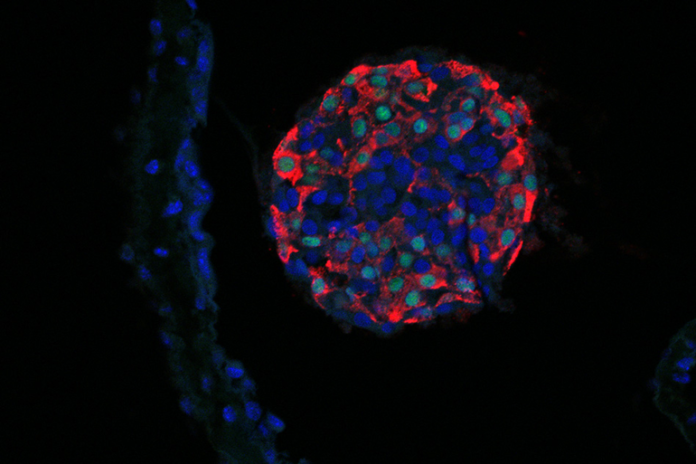
Glucose-stimulated insulin-producing cells, derived from stem cells, are protected inside capsules that are engineered to be invisible to the host immune system.

A stealth material surface, shown here, has been engineered to provide an “invisibility cloak” against the body’s immune system cells. In this electron microscopy image, you can see the material’s surface topography. Image courtesy of the researchers.
Diabetics who undergo pancreatic islet transplantations have to be on immunosuppressants for the rest of their lives, a huge drawback for the usefulness of the technique that would otherwise be revolutionary. Now researchers from MIT, Boston Children’s Hospital, Harvard, University of Illinois at Chicago, and the Joslin Diabetes Center have come up with a way of encapsulating the pancreatic islets within a special material, so that after transplantation they continue to work normally without being attacked by the immune system of the recipient. So far the technique has shown to be effective in laboratory mice for a period of six months, pointing to human trials in the not too distant future.
The researchers tinkered with alginate, a chemical component within brown algae that has been known to encapsulate cells but that also leads to scar formation. The researchers created hundreds of variations of alginate, testing them in mice and monkeys. Eventually they settled on triazole-thiomorpholine dioxide (TMTD) and tested its powers to encapsulate human pancreatic islets derived from stem cells into diabetic mice. The material worked remarkably well, with the islets producing more or less insulin with changes in blood sugar, keeping glucose under control for almost 200 days
Study in Nature Medicine: Long-term glycemic control using polymer-encapsulated human stem cell–derived beta cells in immune-competent mice…
Study in Nature Biotechnology: Combinatorial hydrogel library enables identification of materials that mitigate the foreign body response in primates…
Source: MIT News…
